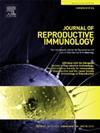典型和非标准产科抗磷脂综合征(OAPS 和 NC-OAPS)患者不同基因表达及免疫和炎症反应机制的转录组学分析。
IF 2.9
3区 医学
Q3 IMMUNOLOGY
引用次数: 0
摘要
在这项研究中,我们通过对10名产科抗磷脂综合征(OAPS)患者和10名非标准产科抗磷脂综合征(NC-OAPS)患者的外周血样本进行转录组测序,研究了典型产科抗磷脂综合征(OAPS)患者和非标准产科抗磷脂综合征(NC-OAPS)患者之间的分子差异。通过基因本体(GO)和京都基因与基因组百科全书(KEGG)富集分析、蛋白-蛋白相互作用(PPI)分析以及竞争性内源性 RNA(ceRNA)网络构建,确定了差异表达基因(DEGs),进而确定了枢纽基因。通过定量实时 PCR(qPCR)对 OAPS(n=9)和 NC-OAPS(n=12)样本进行验证。我们在两组样本中发现了 240 个 DEGs。GO 和 KEGG 分析审查了 OAPS 患者中与炎症反应、免疫反应、抗原处理和呈递、Th1、Th2 和 Th17 细胞分化以及 NK 细胞介导的细胞毒性相关的通路的上调情况。PPI和ceRNA网络分析确定了关键基因,在OAPS组中发现CXCR2、JAK2和MPO显著上调,这与严重炎症、JAK-STAT通路激活和中性粒细胞NET活性增加有关。其他基因,如 CD4、IL2RB 和 NKG7,参与了 T 细胞和 NK 细胞的调节。我们的研究结果表明,OAPS 患者的炎症和免疫反应增强,表明其免疫活动比 NC-OAPS 患者更为严重,这为精确诊断和治疗策略提供了依据。本文章由计算机程序翻译,如有差异,请以英文原文为准。
Transcriptomics analysis of differential gene expression and immune and inflammatory response mechanisms in patients with typical and non-criteria obstetric antiphospholipid syndrome (OAPS and NC-OAPS)
In this study, we investigated the molecular differences between patients with typical obstetric antiphospholipid syndrome (OAPS) and patients with non-criteria obstetric antiphospholipid syndrome (NC-OAPS) patients through transcriptome sequencing of peripheral blood samples from ten OAPS patients and ten NC-OAPS patients. Differentially expressed genes (DEGs) were identified, followed by Gene Ontology (GO) and Kyoto Encyclopedia of Genes and Genomes (KEGG) enrichment analyses, protein-protein interaction (PPI) analysis, and competitive endogenous RNA (ceRNA) network construction to identify hub genes. Verification was performed via Quantitative Real-time PCR (qPCR) in OAPS (n=9) and NC-OAPS (n=12) samples. We identified 240 DEGs in two groups. GO and KEGG analyses reviewed upregulated in pathways related to the inflammatory response; immune response; antigen processing and presentation; Th1, Th2, and Th17 cell differentiation; and NK cell-mediated cytotoxicity in OAPS patients. PPI and ceRNA network analyses identified key genes, with significant upregulation of CXCR2, JAK2, and MPO found in the OAPS group, which correlated with severe inflammation, JAK-STAT pathway activation, and increased NET activity in neutrophils. Other genes such as CD4, IL2RB, and NKG7, are involved in T-cell and NK cell regulation. Our results indicate enhanced inflammatory and immune responses in OAPS patients, suggesting more severe immune activity than in NC-OAPS patients, providing a basis for precise diagnostic and therapeutic strategies.
求助全文
通过发布文献求助,成功后即可免费获取论文全文。
去求助
来源期刊
CiteScore
6.30
自引率
5.90%
发文量
162
审稿时长
10.6 weeks
期刊介绍:
Affiliated with the European Society of Reproductive Immunology and with the International Society for Immunology of Reproduction
The aim of the Journal of Reproductive Immunology is to provide the critical forum for the dissemination of results from high quality research in all aspects of experimental, animal and clinical reproductive immunobiology.
This encompasses normal and pathological processes of:
* Male and Female Reproductive Tracts
* Gametogenesis and Embryogenesis
* Implantation and Placental Development
* Gestation and Parturition
* Mammary Gland and Lactation.

 求助内容:
求助内容: 应助结果提醒方式:
应助结果提醒方式:


